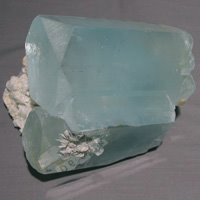JPS translates Shemot 28:20:
chosen as beryl. It probably depends on JPS's source. According to Wikipedia,
The mineral beryl is a beryllium aluminium cyclosilicate with the chemical formula Be3Al2(SiO3)6... It has a vitreous lustre and can be transparent or translucent. Its cleavage is poor basal and its habit is dihexagonal bipyramidal. Pure beryl is colorless, but it is frequently tinted by impurities; possible colors are green, blue, yellow, red, and white. The name comes from the Greek beryllos for the precious blue-green color of sea water.
Until I find contrary information, I will assume they do not mean emerald (smaragd) here but rather either the colorless or the the aquamarine variety, since this would be simply beryl, or would be equal to the ancient Greek beryl. Here is a picture of aquamarine beryl.

This makes some sense because Tarshish was a Biblical site that sent out ships.
Midrash Rabba discusses תַּרְשִׁישׁ, saying: אשר קרומטיסין, that Asher's stone was kromatisin.
What is this? Jastrow (pg 1414) defines this as cover (or color) of gold foils, name of a jewel in the High Priest's breastplate. The Greek is chrusolithos.
According to the International Standard Bible Encyclopedia:
Note that this is not the same as modern chrysolite, but that didn't stop someone from puting in the Wikipedia article on chrysolite/olivine that Rabbenu Baycha identifies tarshish as chrysolite as the stone of Asher.According to Septuagint chrusolithos was one of the stones of the breastplate (lst stone, 4th row), but there is uncertainty as to the Hebrew text of the Septuagint in respect of this word; the name is not mentioned by Theophrastus. The chrysolithus of Pliny was a "transparent stone with a refulgence like that of gold." Those were most valued which "when placed by the side of gold, impart to it a sort of whitish hue, and so give it the appearance of silver."
It may perhaps have included the yellow sapphire (alumina), the yellow quartz (citrine, silica) and the yellow jargoon (zircon; silicate of zirconium) of the present day. The term "chrysolite" is now applied to a different mineral, namely, to a yellow variety of olivine (silicate of magnesium and iron), a species that includes the green precious stone peridot as another of its varieties.
We include no picture here since the specific identification is uncertain.

No comments:
Post a Comment